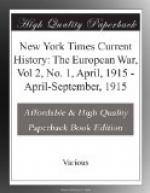Although the maps show the lines of fighting to be rather wavy, one must go to the front really to appreciate the irregular zigzag, snakelike line that it really is. The particular bit of trenches we visited cover a front of twelve miles, but so irregular is the line, so intricate and vast the system of intrenchments, that they measure 200 miles on that particular twelve-mile fighting front.
When one leaves the trenches at the rear of the communication boyaux, it is astonishing how little of the war can be seen. Ten feet after we left our trenches we could not see even the entrance. We stood in a beautiful open field having our pictures taken, and a few hundred yards away our motor waited behind some trees. Suddenly we heard a “zip zip” over our heads. German snipers were taking shots at us.
In addition to the enormous force of men constantly in the trenches along the entire line there is an equal size reserve line directly behind them in case of sudden attack. The artillery is posted considerably further to the rear along with revictualing stations, aeroplane hangars, and headquarters of the Generals, but through all this enormous mass of men which we passed daily going to and from our front observation posts never once did we get the impression of parade. Three were just troops, troops, troops everywhere, every hamlet, every village filled with them, every crossroads with their sentries. All of them, hardened by Winter and turns in the trenches, are in splendid condition, and as opposed to the Germans, at least to the German prisoners I have seen, each French soldier has a clear and definite knowledge of what the war is all about. The greatest event of his day is when the Paris newspapers arrive.
[Illustration]
What impressed me greatly was that in all the officers’ quarters were copies of the French “Yellow Book,” the English “White Paper” and German documents attempting to prove their innocence in causing the conflict. It is not sufficient for French Generals or officers just to go to war; they must know why they go to war, down to the last papers in the case. In six months the French privates have acquired one habit from the British Tommies—that is drinking tea. Back of every section of trenches I found huge tea canteens, where thousands of cups are served daily to the soldiers who have decided for the first time in their life they really like such stuff. There one sees more soldiers at the same time than at any other place in the fighting zone; there they sit and discuss the future calmly and confidently, there being a distinct feeling that the war is likely to be over next Summer.
No one knows what the Spring tactics of General Joffre will be. Along the section of the front I visited the officers are all satisfied that the Commander in Chief’s “nibbling tactics” have forced the Germans to retire on the average of two to three miles all along the line. The very name of that great man is spoken with reverence, almost with awe, by his “children at the front.”




